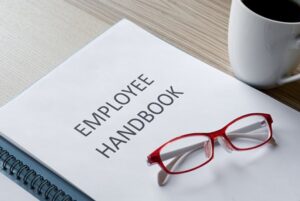How to Craft a Comprehensive Employee Handbook
Posted on September 30, 2016

Here are some tips for writing a better employee handbook:
- Know what you must. Certain employee handbook provisions are required by law. The U.S. Department of Labor provides guidelines for federally required items on its website, and many states offer similar input from the state agency responsible for labor and employment. Required items frequently include family medical leave policies, equal employment and non-discrimination policies, and workers’ compensation policies.
- Align your handbook with your company culture. What’s important to you as a business? What tips, tricks or methods have you found most efficient and effective when accomplishing the work your company does? What values, norms and behavior does your culture embrace – and wish to generate in employees? Issues like dress codes, cell phone etiquette, blogging and social media, and other employee behaviors should be addressed here. Use a positive tone – instead of including a list of “should nots,” set specific, measurable, realistic goals for employee behavior.
- Add some protective reminders. A few general disclaimers in your handbook can help resolve potential lawsuits before they even begin. For instance, you may want to remind readers that the handbook is a guide, not a contract. By explicitly stating the handbook may be subject to change or revisions, it will help you resolve disputes while still giving you the flexibility you need to respond to your business’s changing needs.
- Update regularly. Many businesses treat their handbooks like a “set it and forget it” item. But as your company changes, your policies and procedures may need to be updated as well. Schedule time to review and update the employee handbook at least once a year – more often if your business is growing rapidly or if you’ve faced high employee turnover recently.
Your employee handbook and other employment documents not only set clear expectations and guidelines, but they also protect your company and your employees. To ensure that your company is being as strategic as possible with your staffing and HR matters, rely upon your recruiting partner. As employment experts, they can guide you on what you need to up create or update.
At TERRA Staffing Group, our recruiters can help you create the employee handbook you need to provide clear guidance and respond to the changing dynamics of your business.
Contact us today to learn more about our staffing services in Seattle, Phoenix and Portland.
Categories: Employee Engagement Ideas, HR and Management Advice
Tags: How to Write an Employee Handbook, Recruiting Expert Seattle, Seattle Employment Services, Seattle Recruiting Services, Seattle Staffing and HR, Seattle Staffing Services, Staffing Expert Seattle, What is Included in an Employee Handbook




